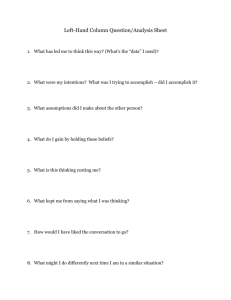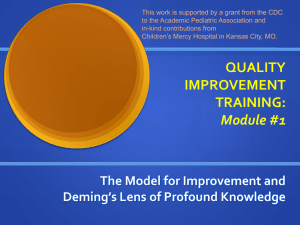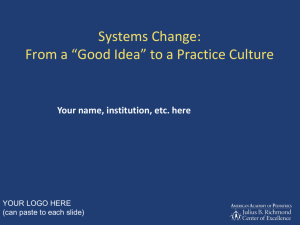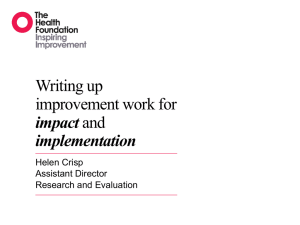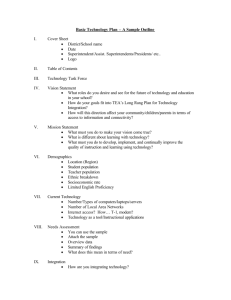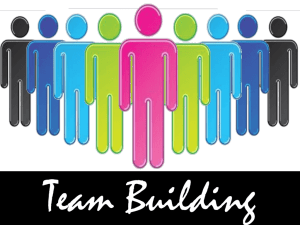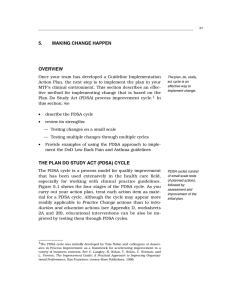The Model for Improvement
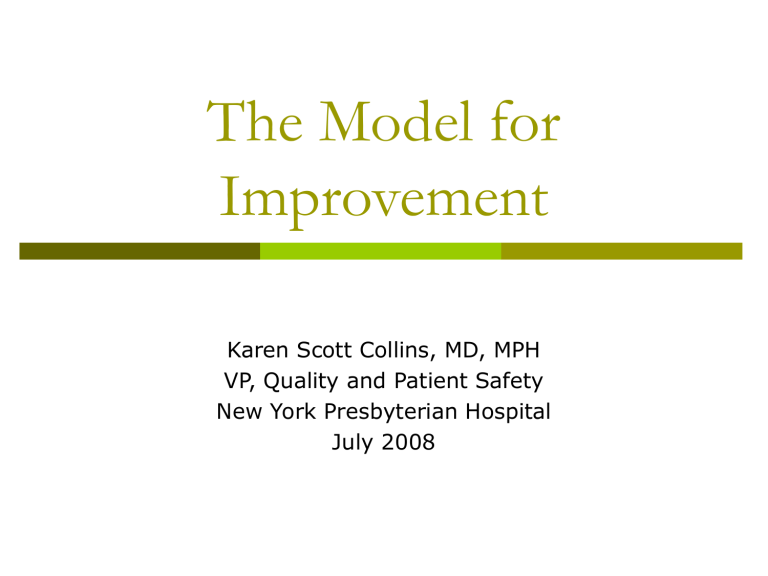
The Model for
Improvement
Karen Scott Collins, MD, MPH
VP, Quality and Patient Safety
New York Presbyterian Hospital
July 2008
Learning Objectives
Understand the Model for Improvement
Discuss how to create aim statements that are measurable and specific
Review the measurement strategy and identify how the key measures relate to the improvement project
Introduce Plan-Do-Study-Act cycles
Key Elements of
Breakthrough Improvement
Will to do what it takes to change to a new system
Ideas on which to base the design of the new system
Execution of the ideas
The Model for Improvement
A simple way to frame, organize, execute improvement work
Useful for testing great ideas, trying things that have worked for others, implementing ripe ideas or actions, and disseminating positive improvements throughout organization
Three Fundamental
Questions for Improvement
1.
What are we trying to accomplish?
2.
How will we know that a change is an improvement?
3.
What changes can we make that will result in improvement?
Compare the 3 questions to how we frame improvement
Aim
What are we trying to accomplish?
Measurement for learning
PDSA
How will we know a change is an improvement?
What changes can we make to bring about improvement?
From: Associates in
Process Improvement
Model for Improvement
What are we trying to accomplish?
How will we know that a change is an improvement?
What change can we make that will result in improvement?
Aim
Measures
Ideas
Act Plan
Study Do
From: Associates in
Process Improvement
Model for Improvement
What are we trying to accomplish?
How will we know that a change is an improvement?
What change can we make that will result in improvement?
Aim
Measures
Ideas
Act Plan
Study Do
Question 1:
What Are We Trying to Accomplish?
Aim:
A written statement of the accomplishments expected from each pilot team’s improvement effort.
Everyone on team has the same goals and expectations
Aim:
What Are We Trying to Accomplish?
Your team’s aim statement should be consistent with the mission of the
improvement work and include:
What is expected to happen
The system to be improved
The setting or (sub-)population of patients
Specific numeric, stretch goals
Time frame
Guidance for activities, such as strategies for the effort, or limitations
Exercise: Aims
Use the following criteria to evaluate the following Aim statement example
Is it consistent with the mission of the
Collaborative/improvement initiative?
Is it clear what is expected to happen by when?
Can you determine the system to be improved?
Can you distinguish the setting or sub-population of patients?
Are specific numeric goals clearly stated?
Is there guidance indicated for the activities, such as strategies for the effort, or limitations?
Aim Statement Asthma Example
The aim for our Clinic is to improve care provided to our pediatric asthma patients using the Chronic Care Model so as to ensure the
Application of evidence based best practices to all patients and improvement in clinical outcomes in the pilot population over the next year. This will be accomplished by:
Providing follow up to an ED or hospital discharge within 7 days for > 80%
Documenting severity assessment for 95% of patients
Review management plans and provide written management plan including shared goal for 85% pts
Appropriate medications for at least 90% of patients w/o contraindications
Increasing symptom free days by at least 50%
Annual immunization against influenza (goal >90%)
Does example meet these criteria?
Is it consistent with the mission of the initiative?
Is it clear what is expected to happen and when?
Can you determine the system to be improved?
Can you distinguish the setting or sub-population of patients?
Are specific numeric goals clearly stated?
Is there guidance indicated for the activities, such as strategies for the effort, or limitations?
YES NO
From: Associates in
Process Improvement
Model for Improvement
What are we trying to accomplish?
How will we know that a change is an improvement?
What change can we make that will result in improvement?
Aim
Measures
Ideas
Act Plan
Study Do
Question 2: How will we know a change is an improvement?
Requires measurement
Can collect qualitative & quantitative data
Test small first
Test under a wide variety of conditions to make sure idea is robust enough
Measurement for Improvement
Builds will/ Creates tension for change
Demonstrating performance gap overall
Demonstrating variability in performance
Focuses teams – “you can manage what you measure”
Designed to help your improvement team learn and establish improvement priorities
Like a growth curve: it’s not where you are, but where you are going
Answers the question: Are changes an improvement?
IS NOT:
Designed for criticism or punishment
Supposed to end (it should be sustainable )
Types of Measures
1.
Outcome Measures
Results – system level performance
How is the health of the patient affected?
2.
Process Measures
Inform changes to the system
Are key changes being implemented in the system?
3.
Balancing Measures
Signal “robbing Peter to pay Paul”
Measures - Examples
Outcome
Number symptom free days for asthma patients
ED asthma visits
Process
Patient and family have Asthma Action Plan
Appropriate medications prescribed
Balancing
Clinic cycle time
Measurement Guidelines
Need a balanced set of 5 to 8 measures reported each month to assure that the system is improved
These measures should reflect your aim statement & make it specific
Measures are used to guide improvement and test changes
Integrate measurement into daily routine; use patient population database
Plot data for the measures over time and annotate graph with changes
Methods of Measurement
Clinical measures of patients’ health
Documentation of behaviors
Questionnaires
Assessments
Summary of databases
Chart audits
Observations
Integrate Data Collection for
Measures in Daily Work
Include the collection of data with another current work activity
Develop an easy-to-use data collection form or make Information
Systems/registry input and output easy for clinicians
Clearly define roles and responsibilities for on going data collection
Set aside time to review data with those who collect it
Plotting Data in Time Order
Summary statistics hide information
(patterns, outliers)
In improvement efforts, changes are not fixed, but are adapted over time
Time series graphs annotated with changes and other events provide evidence of sustained improvement
QI Tools - Run Chart
Percent of Patients with Planned Care Visits
100%
90%
80%
70%
60%
50%
40%
30%
20%
10%
0%
GOAL
Ja nu ar y
Fe br ua ry
Tried encount er forms
M ar ch
A pr il
M ay
Ju ne
Nurse
Smith left
Implemented registry
Ju ly
A ug us t
S ep te m be r
O ct ob er
N ov em be r
D ec em be r
Lessons from Baseline Data Collection
What worked?
What didn’t work?
What was difficult?
Why?
Ideas for successful measurement and data collection
From: Associates in
Process Improvement
Model for Improvement
What are we trying to accomplish?
How will we know that a change is an improvement?
What change can we make that will result in improvement?
Aim
Measures
Ideas
Act Plan
Study Do
Question 3: What Changes Can We
Make That Will Result in Improvement?
Use change concepts, models (Chronic
Care Model), literature, shared experiences to develop specific changes
Test: good ideas, ready for use or ready for adaptation to your environment
Change Concepts vs.
High Leverage Changes
Vague, strategic, creative
Improve care of asthma patients
Share info w/ patients & families and encourage self-management
Document asthma management plan and goals for self-management
Specific, actionable, results
Begin discussion of SM goals w/ 3 patients on Monday
From:: Associates in
Process Improvement
Model for Improvement
What are we trying to accomplish?
How will we know that a change is an improvement?
What change can we make that will result in improvement?
Act Plan
Study Do
The PDSA Cycle for Learning and
Improvement
Act
• What changes are to be made?
• Next cycle?
Plan
•
Objective
• Questions and predictions (why)
• Plan to carry out the cycle
(who, what, where, when)
• Plan for data collection
Study
•
Complete the analysis of the data
• Compare data to predictions
• Summarize what was learned
Do
• Carry out the plan
• Document problems and unexpected observations
• Begin analysis of the data
Use the PDSA Cycle for:
Helping to answer the first two questions of the Model for
Improvement
Developing a change
Testing or adapting a change idea
(from a component of the Care Model)
Implementing a change
Why Test?
Increase your belief that the change will result in improvement
Opportunity for learning from “failures” without impacting performance
Document how much improvement can be expected from the change
Learn how to adapt the change to conditions in the local environment
Evaluate costs and side-effects of the change
Minimize resistance upon implementation
Repeated Use of the PDSA Cycle
Multiple cycles
Changes that
Result in
Improvement
A P
S D
Proposals,
Theories,
Ideas
A P
S D
3 Principles for Testing a Change
1.
2.
3.
Test on a small scale
Collect data over time
Build knowledge sequentially with multiple PDSA cycles for each change idea. Include a wide range of conditions in the sequence of tests
To Be Considered a
PDSA Cycle:
The test or observation was planned (including a plan for collecting data)
The plan was attempted (do the plan)
Time was set aside to analyze the data and study the results
Action was rationally based on what was learned
Test on a Small Scale
Conduct the test in one facility or office in the organization, or with one customer
Test the change on a small group of volunteers
Develop a plan to simulate the change in some way
Decrease the Time Frame for a PDSA Test Cycle
Years
Quarters
Months
Weeks
Days
Hours
Minutes
Drop down next
“two levels” to plan Test Cycle!
Global Collaborative Measures vs.
PDSA Cycle Measures
Achieving
Aim
Adapting
Changes
During
PDSA Cycles
Project Measures :
Overall results related to the project aim
(core measures and teams’ additional and balancing measures)
PDSA Measures
-PDSA-specific measures:
•
Quantitative data on the impact of a particular change
• Qualitative data to help refine the change
Fundamental Questions for
Improvement
What are we trying to accomplish?
Model for Improvement Team Aim Statement
What are we trying to accomplish?
How will we know that a change is an improvement?
How will we know that a change is an improvement?
What change can we make that will result in improvement?
Measures
What changes can we make that will result in an improvement?
Change package
Act Plan
Study Do
References
The Improvement Guide: A Practical Approach to
Enhancing Organizational Performance. G. Langley, K.
Nolan, T. Nolan, C. Norman, L. Provost. Jossey-Bass
Publishers., San Francisco, 1996.
Quality Improvement Through Planned
Experimentation. 2nd edition. R. Moen, T. Nolan, L.
Provost, McGraw-Hill, NY, 1998.
“Understanding Variation”, Quality Progress, Vol. 13,
No. 5, T. W. Nolan and L. P. Provost, May, 1990.
A Primer on Leading the Improvement of Systems,”
Don M. Berwick, BMJ, 312: pp 619-622, 1996.
“Accelerating the Pace of Improvement - An Interview with Thomas Nolan,” Journal of Quality Improvement,
Volume 23, No. 4, The Joint Commission, April, 1997.
Jane Taylor, Improvement Advisor, IHI
Pat Heinrich, VP, NICHQ

